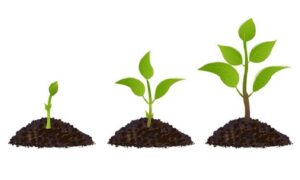Plant Growth Regulators Definition
Plant growth regulators may be defined as any organic compounds, which are active at low concentrations (1-10 ng / nl) in promoting, inhibiting or modifying growth and development. The naturally occurring (endogenous) growth substances are commonly known as plant hormones, while the synthetic ones are called growth regulator.
Plant hormone is an organic compound synthesised in one part of the plant and translocated to another part, where in very low concentrations it causes a physiological response. The plant hormones are identified as promoters (auxins, gibberellin and cytokinin), inhibitors (abscissic acid and ethylene) and other hypothetical growth substance (florigen, flowering hormone, etc.,)
Plant Growth Regulators Characteristics
- Plant growth regulators (PGR)- small, simple molecules can be indole compounds (indole three acetic acid), adenine derivative (N6 – furfuryl amino purine, kinetin), carotenoid (abscisic acid), terpenes (gibberellic acid), gases(C2H4),
- One group- plant growth promoters. E.g., auxin, gibberellin, cytokinin growth-promoting activities (division, flowering, enlargement, seed form).
- Other group – Growth inhibiting activities (dormancy, abscission), response to wounds & stresses of biotic & abiotic origin.
- C2H4 fits either of the group (mainly inhibitor).
Discovery of Plant Growth Regulators
Charles Darwin, Prances Darwin(son)
- Observed coleoptiles of canary grass responded to unilateral illumination by growing towards light source(phototropism) tip of coleoptile- site of transmittable influence.
- Auxin- by F.W. Went from the tip of coleoptile of oat seedlings.
- Bakanae (foolish seedling) disease of rice seedling by a fungal pathogen. Gibberella fujikuroi (noticed by E. Kurosawa). The active substance was identified as gibberellic acid.
- F. Skoog observed that from internodal segments of tobacco stems, callus proliferated if the nutrient medium had auxin, extracts of vascular tissue/yeast extract/coconut milk.
- Three inhibitors – Inhibitor B, abscission II, and dormin (chemically identical – abscisic acid)
- Cousins confirmed the release of a volatile substance from ripened orange that hastened the ripening of stored unripened bananas. Volatile substance – Ethylene.
Click Here for Complete Biology Notes
Physiological Effects of Regulators –
1 . Auxin –
- (Greek word Auxin – to grow) from human urine.
- Applied to IAA & growth-regulating component, produced by growing apices of stem & root from where migrate to the region of action. E.g.- IAA & indole butyric acid (IBA); NAA (Naphthalene acetic acid) & 2,4-D (2,4 diclorophenoxy acetic)- synthetic.
- Initiate rooting in stem cuttings (plant propagation), promote flowering (pineapples), prevent fruit & leaf drop at an early stage, promote abscission of older leaves & fruits, control xylem differentiation, induce parthenocarpy (tomatoes), used as herbicides, 2,4 D (kill dicot weed, not monocot), prepare unweed free lawns.
- Apical bud inhibits the growth of lateral buds – apical dominance. Removal of shoot tips (decapitations) results in lateral buds’ growth, applied in tea plantation, hedge making.
2. Gibberellins
- Promote PGR. (More than 100), denoted as GA1, GA2.
- 1st gibberellins- Gibberellic acid (GA3) – speed up the malting process.
- Acidic, more length of the axis (length of grapes stalks), cause fruits like apples to elongate & improve the shape and delay senescence.
- Sugarcane stores sugar in the stem, with gibberellins, yield increases to 20 tons per acre. On conifers, hastens maturity period.
- Promote bolting (internode elongation) in Beed, cabbage, plants with rosette habits.
3. Cytokinin
- Discovered as kinetic from autoclaved herring sperm DNA.
- It does not occur naturally, synthesized in rapid cell division area (root apices, shoot buds, fruit), produce leaves(new), lateral shoot growth, adventitious shoot formation, overcome apical dominance, promote nutrient mobilization (delay senescence).
- Search to similar substances led to zeatin from corn kernels & coconut milk (cell division promoting activities).
4. Ethylene
- Simple gaseous PGR.
- Significant amount synthesis, horizontal growth of the seedling, swelling of the axis, apical hook formation(dicot seedling), promote senescence & abscission of plant organs, effective in fruit ripening, enhance respiration rate (respiratory climactic), breaks seed & bud dormancy, initiate germination (peanut), sprouting of tubers, promote internode elongation in deepwater rice plants, leaves remain above water, promote root growth, root hair formation (increase absorption surface), initiate flowering(mango).
- Ethephon – Readily absorbed in the aqueous medium, transported within a plant, hasten fruit ripening (tomatoes, apples), accelerate abscission (cotton, cherry, walnut), promote female flowers(cucumber).
5. Abscisic acid
- Growth inhibitor.
- Inhibits seed germination, close stomata, high tolerance to stress (Stress hormone), Seed division, dormancy, withstand desiccation, antagonist to GAs.
Related Posts
- Phylum Porifera: Classification, Characteristics, Examples
- Dissecting Microscope (Stereo Microscope) Definition, Principle, Uses, Parts
- Epithelial Tissue Vs Connective Tissue: Definition, 16+ Differences, Examples
- 29+ Differences Between Arteries and Veins
- 31+ Differences Between DNA and RNA (DNA vs RNA)
- Eukaryotic Cells: Definition, Parts, Structure, Examples
- Centrifugal Force: Definition, Principle, Formula, Examples
- Asexual Vs Sexual Reproduction: Overview, 18+ Differences, Examples
- Glandular Epithelium: Location, Structure, Functions, Examples
- 25+ Differences between Invertebrates and Vertebrates
- Lineweaver–Burk Plot
- Cilia and Flagella: Definition, Structure, Functions and Diagram
- P-value: Definition, Formula, Table and Calculation
- Nucleosome Model of Chromosome
- Northern Blot: Overview, Principle, Procedure and Results
















